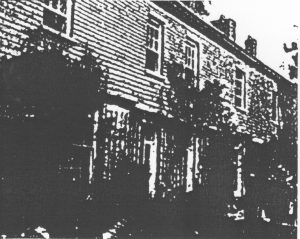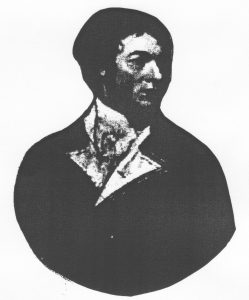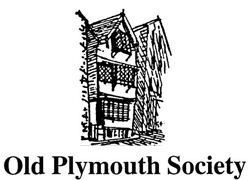by Len Stephens
Published May 2012
I began my article on Prospect House in the March Newsletter referring to my research into the historic sites/buildings that bordered on what is now Central Park. Very little has been recorded about these historic houses except for references in C.W. Bracken’s History of Plymouth, booklets by Robert Groves and David Ayers which can be seen in the Plymouth Local Studies Library, and occasional articles in the local press. This is a great pity since only one house – Pounds House – now remains.
When the City Council called for ideas in 1992 for the future use of Pounds House, which had been refurbished after the fire, I suggested that it should be a heritage centre/museum for the history of local historic houses and their occupants. For various reasons, including financial, this was not taken up and I thought that this Newsletter should have the benefit of my researched notes on three houses which were still in existence at the beginning of the century but alas have now disappeared.
Swilly House
Firstly Swilly House, which appears on the Gardner Survey Map of 1784, was a Tudor Manor house with an estate of 50 acres. The name Swilley (the e was later dropped) is derived from the Saxon “Swylle” meaning a place by a stream or hollow place in a gutter washed out by soil. It was originally one of the farms situated at the head of Keyham Creek (now St. Levan Road) and the house appears to have been built in the 16th century by the Kempe and Rowe families. Early records show the owners as Walter Kempe 1563 – 1573, Robert Kempe 1573 – 1606, and Tobias Kempe 1606 – 1621.

Walter’s son William Kempe was the renowned Headmaster of Plymouth Grammar School from 1581 to 1604. Emma Kempe, daughter of Tobias, owned one-eighth of Swilley in her own right and in 1652 she married John Furneaux of Buckfastleigh so starting the long connection of Swilly House with the Furneaux family. In 1663 John purchased three-quarters of the leasehold for £210 and the remaining one-eighth from the Rowe family for £120 and from then on the Furneaux family lived at Swilly until 1921.
John and Emma had three sons: Christopher, John and Tobias the last, not the eldest, inherited Swilly. The other two became property owners and were both ordained. John became Curate of Plympton St. Mary and Christopher, Vicar of Whitchurch.
Tobias (1658 – 1740) is the one of immediate interest. He married Grace Rowe (who may have had connections with the Rowes of Swilly) and later, at the ripe old age of 82, he gave Swilly to his only surviving son William at a rent of £52 per annum and then retired to Plymouth. William (1696-1748) married Susanna Willcocks in 1722 and had three surviving sons and two daughters. All three sons James (born 1725), Tobias (born 1735) and Abraham (born 1737) served in the Navy. This was possibly influenced by their mother’s connection with the family of Wallis or by the famous Admiral Boscawen who dined at Swilly when he was in Plymouth. However, neither James nor Abraham pursued a career in the Navy, Abraham the youngest son died unmarried in 1733 at the age of 36, whilst the eldest James was to inherit Swilly and it is from him that the Furneaux line continued.
But first let us confine ourselves to Tobias who bore the name of his grandfather, who had himself taken the name of his grandfather Tobias Kempe. He was to make the Navy his career and although he never owned Swilly House it is most remembered because of him.
Captain Tobias Furneaux RN – The Circumnavigator
The memorials of his life are few, his journals, logs and letters are preserved in the British Museum and Public Record Office. Except for two recent plaques, one on the wall of the Cardinal Petrol Station on the corner of Wolseley Road and North Prospect Road and the other on a wall overlooking the Mayflower Steps commemorating Plymouth men who helped form modern Australia, he is hardly remembered by his home town. His exploits appear to go unsung, except for F.S. Blight’s lecture to the Plymouth Institution on the 16th March 1952, so this is a brief account of his distinguished career.

Tobias, like his brothers, received his early education from the local vicar of Stoke Damerel Church and his father, a former lecturer at Oxford University. There is no knowledge of his early career until we find him recorded as a Midshipman on HMS Marlborough in 1755, although this may well have been his seventh year at sea since he might have served as a “Captain’s servant” to Captain Byron. During the Seven Years War with France (1756-1763) the Marlborough was stationed in the West Indies as the flagship of Vice-Admiral Cotes at Jamaica where Tobias was in action against French privateers in 1758 and was promoted to Lieutenant commanding a sloop.
He returned to England as 4th Lieutenant of the Edinburgh, a third rate; his commission was confirmed on 2nd December 1760, and the next day he was appointed Second Lieutenant of the Melampe, which saw action in the English Channel resulting in his promotion to First Lieutenant in July 1762.
The Melampe sailed to Barbados in 1763 where Tobias was transferred to the Ferret to return to England. He was paid off on 14th July 1763, five months after the Peace of Paris and he returned to live at Swilly on half pay and prize money until commissioned as Second Lieutenant of the Dolphin on 16th July 1766.
The great moments of his naval career were to be spent in the Pacific Ocean, hitherto uncharted by the Navy, which he crossed in two famous voyages of exploration. The first time was on the Dolphin in Captain Samuel Wallis’s voyage of circumnavigation (1766 – 1768). Wallis was instructed by the Admiralty to sail to the Pacific via the Strait of Magellan on a course designed to bring the Dolphin to the hitherto uncharted New Zealand. They were not to achieve their objective because the severe conditions that the Dolphin encountered in the Strait resulted in Wallis and his First Lieutenant being taken ill and Tobias had to take command for part of the ship’s progress across the Pacific to the north of New Zealand. However, they were the first Europeans to discover the Society Islands and Tahiti where Tobias hoisted the flag to claim it, Wallis calling it King George Ill Island in 1767. They completed the voyage home via the Java Seas, Indian Ocean, Cape of Good Hope and the Atlantic Ocean.
The task of discovering New Zealand and Australia was left to Captain James Cook’s second voyage to the South Seas (1772-1774), and the choice of Tobias Furneaux as his second in command was an obvious one. Tobias had been paid off from the Dolphin on 24th June 1768 and recuperated at Swilly until his next appointment on 3rd December 1770 as Third Lieutenant of the Trident, a 3rd rate of 1366 tons and 64 guns.
His stay was short, for he was transferred to the Torbay, a 3rd rate of 1572 tons and 74 guns, where he became Second Lieutenant under Captain Wallis. In 1771 Captain Cook for his voyage obtained two Whitby built colliers, the Drake of 460 tons and Raleigh of 336 tons which were renamed the Resolution and the Adventure. Cook, in command of the expedition, was appointed Captain of the Resolution with a rank of Commander RN on 28th November 1771 with Tobias as Captain of the Adventure also with the rank of Commander, junior by a day. In this voyage Tobias was to circumnavigate the world in the opposite direction to his first, so becoming the first to sail round the world in both directions.
The ships left Plymouth on 13th July 1772 bound for the Cape of Good Hope, then sailing eastwards to the uncharted continent of Australia. They arrived at the Cape on 31st October 1772 and on 23rd November sailed southwards into a “thrilling region of thick-ribbed ice”, the Ice Islands of the Antarctic Circle. Sailing through blinding snowstorms and thick fog the ships became separated and on 8th February 1773 Tobias, carrying out previous instructions, took the Adventure on an eastward course to arrive on 9th March at Tasmania, then called Van Diemen’s Land, where he charted and explored the coast. In honour of his Westcountry home he conferred the names of Eddystone Point, Mewstone, and Swilly on places in Tasmania.
Captain Cook also honoured him by naming the islands off Tasmania, the Furneaux Group. After meeting up with Cook in Queen Charlotte Sound in New Zealand on 71 April 1773 the Resolution and Adventure together sailed to Tahiti and carried out further exploration of the South Seas islands before parting again. Captain Furneaux took the Adventure back to England via Cape Horn and the Cape of Good Hope, thus circumnavigating the world in the opposite direction to his first voyage. He arrived back at Spithead on 12th July 1774, a year ahead of Captain Cook, and he brought back with him a native of Otaheite (Tahiti) named Omari who was presented to the King. Tobias was then to be swept up in the American War of Independence. He was promoted to Captain RN on 101h August 1775 and given command of the Syren, a frigate 6th rate of 603 tons and 28 guns, which sailed from Plymouth to join the squadron of Rear Admiral Sir Peter Parker at Cape Fear, North Carolina on 3rd January 1776. He saw action at Charlestown and the Syren was part of the fleet that captured Newport, Rhode Island on 8th December 1776. The year 1777 was a fated one for British interests in America and for Tobias, whose ship went down on 6th November 1777, when he and his crew were taken prisoners until the following year. Before returning to England without a ship he served as a volunteer on the Isis, one of Admiral Howe’s ships, in action at Rhode Island. His career was brought sharply to a close in 1779 when as a victim of what was then termed gout he was invalided on half pay and died in September 1781 at his birth place Swilly. He was buried in the family vaults at Stoke Damerel Church. Had he lived longer than his 46 years, Tobias might have become an Admiral.
The elder brother James died 4 years after Tobias but his widow (he had married Elizabeth Rowe) continued to live at Swilly for some considerable time. A Mrs. Furneaux is shown in Brindley Directory 1830 as residing in Swilly House but I doubt whether she was the widow of the elder James, but rather of the younger who was the son, born in 1752, who became vicar of Anthony-by-Torpoint. He had married Harriet Foot and had 4 sons, one John, born in 1793, followed in the footsteps of his illustrious great uncle Tobias, entering the Navy and remaining unmarried. He died in 1865 reaching the rank of Vice-Admiral but lived at Swilly House.
Of the other 3 sons of the Rev. James, William became a Major-General in the Army, James became a judge in Burdwan, India and the third Tobias became a MA and vicar of St. Germans, Cornwall and died at the age of 82.
Whilst the Swilly estate remained in the family until the 1920s I cannot find any record of the Furneaux’s as resident after 1860. In White’s Directory of that year James and Captain John Furneaux are shown as residents of Swilly House but in later directories of the 19th century the names Misses Hamilton appear and in 1914-18, a Mrs Pigot, all possibly relatives. Rupert Furneaux, who wrote the life of his illustrious ancestor Tobias in 1960, states that his father’s cousin Mordaunt disposed of the estate. Rupert was a great grandson of the third Tobias, the vicar of St. Germans, whereas Mordaunt was probably a grandson of brother James.
The Rev. William Mordaunt Furneaux does not appear to have resided at Swilly. He was Headmaster of Repton and Dean of Winchester, and in 1919/20 decided to sell off most of the family estate (about 50 acres) to the Plymouth Corporation for building council housing, but the house with 5 acres of gardens were not included. They were sold later by auction by Viner Carew & Co. on 17th June 1926, and bought by Mr. Percy Cohen for £3,000 (according to a note on a Sale Catalogue in the Plymouth Local Studies Library). The catalogue showed a picture
————— MISSING TEXT ———–
Methodists transferred their mission to Montpelier School in 1906 and Belair House was demolished two years later and so was lost another picturesque historic building. However, its name was carried on with Belair Road and Elphinstone Road (which is near the site of Belair House) perpetuates the name of its renowned owner.
Montpelier House
This was another Georgian residence with naval connections, built in the late 18th century just up the hill from Belair. In Morris & Co.’s Directory of Devonshire 1870 it states that Captain Sir Edward Pellew, Bart, had occupied Montpelier from 1807 to 1811. He was a brilliant naval commander who gained his baronetry for his gallantry and saving of lives at the wreck of the East Indiaman Dutton that went ashore under the Citadel in 1796 and is so remembered by Dutton’s Cafe.
He subsequently rose to the rank of Vice-Admiral and commanded the Mediterranean Fleet. Among his many exploits was the bombardment of Algiers upon the refusal of the Dey to abolish Christian slavery. This action brought him a Viscountry in 1814 with the title of Lord Exmouth and later he became Commander-in-Chief Plymouth from 1828 to 1832.
It seems that he transferred Montpelier House to his elder son Captain Pownell Pellew RN, as the Directory of 1812 shows him occupying the property. However, it had changed hands by 1830 when Brindley Directory lists Montpelier in the tithing of Pennycross, 2 miles from Devonport on the Tavistock road the residence of Robert Rundle, Esq. He was again shown as resident in White’s 1850 Directory. The house appeared on all maps in the 19th century but des not appear on a 1907 map when it had been pulled down to make way for Westeria Terrace and Hawthorn Grove, built on the site.
It has subsequently given its name to Montpelier Road/Terrace and the Primary School. It seems that true to naval tradition the house’s last occupant was to be a Captain Bertram Williams RN (listed in White’s 1890 Directory). As for its former illustrious naval occupant his name lives on in Exmouth Road and Pellew Place.
